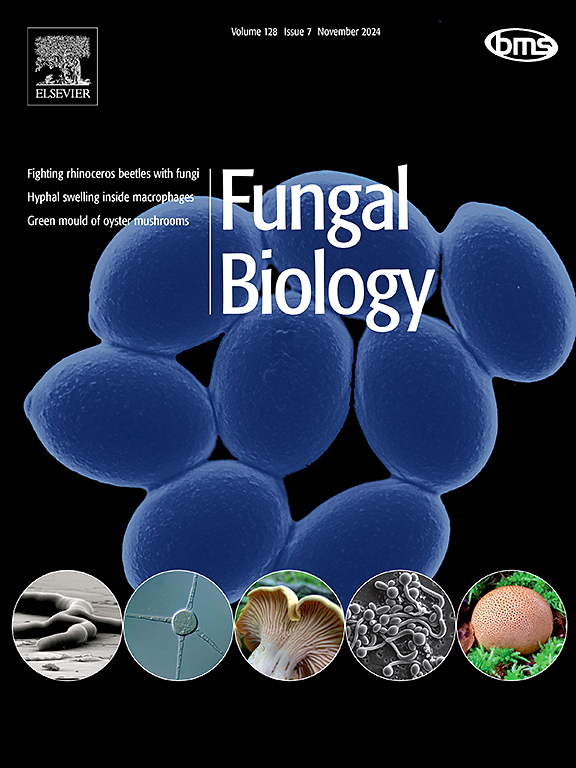对氟定量方法的系统评价确定了一种合适的测量方法,用于研究全氟烷基和多氟烷基物质的真菌脱氟
IF 3
3区 生物学
Q2 MYCOLOGY
引用次数: 0
摘要
全氟烷基和多氟烷基物质(PFASs)的大规模生产和处置引起了全球关注,需要进行调查以了解其生态影响。腐养真菌是生态系统中主要的养分回收者,而它们在转化PFAS中的作用仍未得到充分开发。特别是,缺乏适当的方法来快速测量真菌培养物释放的氟阴离子,以了解其脱氟能力和机制。在本研究中,我们系统地评估了三种在木材腐烂真菌培养条件下定量游离氟化物阴离子的常用方法。基于氟化物催化的二甲酚橙-锆(XO-Zr4+)动致变色反应和基于茜草精-氟化镧(Al-La3 +- f -)三元络合反应的两种分光光度测定方法成功地适用于高通量微孔装置,用于检测微摩尔水平的氟化物,但必需的真菌培养基成分对两种测定方法都存在显著干扰。第三种方法依靠电位器和氟离子选择电极(F-ISE),显示出很强的抗真菌营养物质、代谢物和PFAS干扰的能力,使其成为研究真菌deF的最合适方法。使用F-ISE,我们进一步演示了使用模型PFAS、4,4,4-三氟-3-(三氟甲基)crotonic酸和木腐真菌Trametes versicolor进行deF测试。总之,我们的研究确定了一种可靠的氟化物定量方法,可以评估真菌培养物的pfas -去氟表型。本文章由计算机程序翻译,如有差异,请以英文原文为准。
Systematic evaluation of fluoride quantification methods identifies an appropriate measurement for studying fungal defluorination of per- and Polyfluoroalkyl substances
The large-scale manufacturing and disposal of Per- and Polyfluoroalkyl substances (PFASs) are causing global concerns, and investigations are needed to understand their ecological impacts. Saprotrophic fungi are dominant nutrient recyclers in ecosystems, while their roles in transforming PFAS remain largely untapped. Particularly, there is a lack of appropriate means to rapidly measure fluoride anions released by fungal cultures to understand their defluorination (deF) capacities and mechanisms. In this research, we systematically evaluated three prevalent means for quantifying free fluoride anions under cultural conditions of wood decay fungal species. Two spectrophotometric measurings, including one based on the fluoride-catalyzed kinetochromic reaction of Xylenol Orange-Zirconium (XO-Zr4+) and another one based on Alizarin-Lanthanum-Fluoride (Al–La3+-F-) ternary complexone reaction, were successfully adapted to a high-throughput micro-well setup for detecting micromolar-level fluoride, but essential fungal media components pose significant interference to both assays. The third method, relying on the potentiometer and fluoride ion-selective electrode (F-ISE), demonstrated a strong capacity for anti-interferences of fungal nutrients, metabolites, and PFAS, leaving it a most appropriate method to study fungal deF. With F-ISE, we further demonstrated a deF test using a model PFAS, 4,4,4-trifluoro-3-(trifluoromethyl) crotonic acid, and a wood rot fungus Trametes versicolor. Together, our research identifies a reliable fluoride quantification method that can allow assessing fungal cultures for their PFAS-defluorinating phenotypes.
求助全文
通过发布文献求助,成功后即可免费获取论文全文。
去求助
来源期刊

Fungal biology
MYCOLOGY-
CiteScore
5.80
自引率
4.00%
发文量
80
审稿时长
49 days
期刊介绍:
Fungal Biology publishes original contributions in all fields of basic and applied research involving fungi and fungus-like organisms (including oomycetes and slime moulds). Areas of investigation include biodeterioration, biotechnology, cell and developmental biology, ecology, evolution, genetics, geomycology, medical mycology, mutualistic interactions (including lichens and mycorrhizas), physiology, plant pathology, secondary metabolites, and taxonomy and systematics. Submissions on experimental methods are also welcomed. Priority is given to contributions likely to be of interest to a wide international audience.
 求助内容:
求助内容: 应助结果提醒方式:
应助结果提醒方式:


